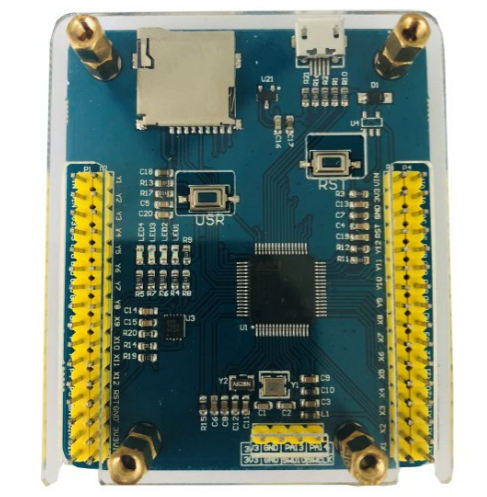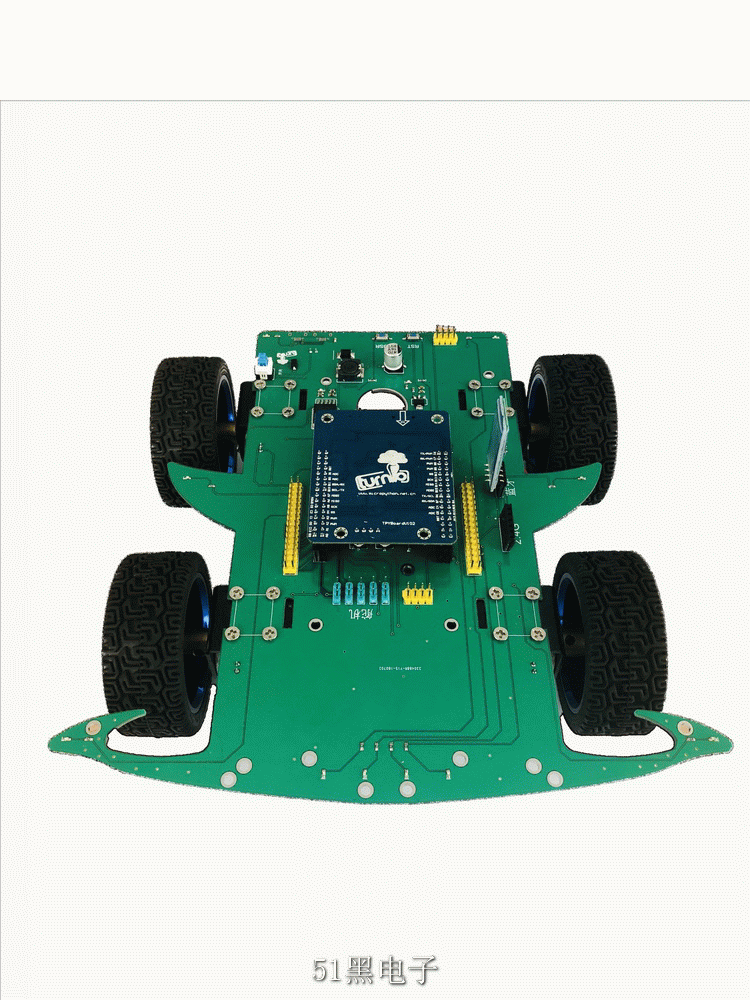智能小車作為現代的新發明,是以后的發展方向,他可以按照預先設定的模式在一個環境里自動的運作,不需要人為的管理,可應用于科學勘探等等的用途。智能小車能夠實時顯示時間、速度、里程,具有自動尋跡、尋光、避障功能,可程控行駛速度、準確定位停車,遠程傳輸圖像等功能。下面帶大家做一個智能藍牙小車,用手機APP來控制小車前進、后退、向左、向右、停止,本次藍牙小車的設計在于探索藍牙智能小車的設計理念及設計方法,學習一下PWM控制電機差速來控制小車的方向,下面就動手搞起來吧!!!!!
1.效果展示
給大家上視頻連接,可以藍牙控制,可以手柄控制哦
https://v.qq.com/x/page/k0721or47dw.html
2.材料準備
TPYBoard v102 1塊
藍牙串口模塊 1個
TPYBoard v102小車擴展板(包含4個車輪,4個電機)
18650電池 2節
數據線 1條
杜邦線 若干
藍牙APP (http://old點tpyboard點com/download/tool/190.html)
3.藍牙模塊
藍牙( Bluetooth):是一種無線技術標準,可實現固定設備、移動設備和樓宇個人域網之間的短距離數據交換(使用2.4-2.485GHz的ISM波段的UHF無線電波)。
我們在此使用的藍牙模塊(HC-06)已經在內部實現了藍牙協議,不用我們再去自己開發調試協議。這類模塊一般都是借助于串口協議通信,因此我們只需借助串口將我們需要發送的數據發送給藍牙模塊,藍牙模塊會自動將數據通過藍牙協議發送給配對好的藍牙設備。

4.單片機-TPYBoard v102
TPYBoard v102 是遵循MIT協議,由TurnipSmart公司制作的一款MicroPython開發板,它基于STM32F405單片機,通過USB接口進行數據傳輸。該開發板內置4個LED燈、一個加速度傳感器,可在3V-10V之間的電壓正常工作。讓你會Python就能做極客, 用Python控制硬件,支持Python語言的開發板。比樹莓派更小巧,更簡單,更便宜,比Arduino更強大,更加容易編程。

小車擴展板
以TPYBoard v102開發板為主控板,小車擴展板具有四路PWM調速電機、8個可控LED、1個蜂鳴器、5路舵機接口、1個藍牙接口、1個PS2無線接口、引出TPYBoard v102開發板全部針腳,可裝載循跡模塊、超聲波模塊、機械手臂、紅外接收頭,兼容入門級電機和專業級電機,兩節18650單獨供電。

源代碼
我們只需要把TPYBoard v102 插小車擴展板上,把藍牙模塊插上,把程序寫入就行,下面是main.py源程序
- # main.py -- put your code here!
- from pyb import Pin
- from pyb import UART
- N1 = Pin('Y1', Pin.OUT_PP)
- N2 = Pin('Y2', Pin.OUT_PP)
- N3 = Pin('Y3', Pin.OUT_PP)
- N4 = Pin('Y4', Pin.OUT_PP)
- N5 = Pin('Y6', Pin.OUT_PP)
- N6 = Pin('Y7', Pin.OUT_PP)
- N7 = Pin('Y8', Pin.OUT_PP)
- N8 = Pin('Y9', Pin.OUT_PP)
- led_red=Pin('Y5', Pin.OUT_PP)
- led_right=Pin('Y12', Pin.OUT_PP)
- led_left=Pin('Y11', Pin.OUT_PP)
- led_red.value(1)
- led_right.value(0)
- led_left.value(0)
- blue=UART(1,9600,timeout=100)
- def go(speed):
- M1_0=pyb.Timer(8, freq=10000).channel(1, pyb.Timer.PWM, pin=pyb.Pin.board.Y1, pulse_width=(speed*200)+10000)
- M1_1=pyb.Timer(8, freq=10000).channel(2, pyb.Timer.PWM, pin=pyb.Pin.board.Y2, pulse_width=0)
- M2_0=pyb.Timer(4, freq=10000).channel(3, pyb.Timer.PWM, pin=pyb.Pin.board.Y3, pulse_width=(speed*100)+5000)
- M2_1=pyb.Timer(4, freq=10000).channel(4, pyb.Timer.PWM, pin=pyb.Pin.board.Y4, pulse_width=0)
- M3_0=pyb.Timer(1, freq=10000).channel(1, pyb.Timer.PWM, pin=pyb.Pin.board.Y6, pulse_width=(speed*220)+10000)
- M3_1=pyb.Timer(1, freq=10000).channel(2, pyb.Timer.PWM, pin=pyb.Pin.board.Y7, pulse_width=0)
- M4_0=pyb.Timer(2, freq=10000).channel(3, pyb.Timer.PWM, pin=pyb.Pin.board.Y9, pulse_width=(speed*50)+5000)
- M4_1=pyb.Timer(12, freq=10000).channel(2, pyb.Timer.PWM, pin=pyb.Pin.board.Y8, pulse_width=0)
-
- led_red.value(0)
-
- def back(speed):
- M1_0=pyb.Timer(8, freq=10000).channel(1, pyb.Timer.PWM, pin=pyb.Pin.board.Y1, pulse_width=0)
- M1_1=pyb.Timer(8, freq=10000).channel(2, pyb.Timer.PWM, pin=pyb.Pin.board.Y2, pulse_width=(speed*200)+10000)
- M2_0=pyb.Timer(4, freq=10000).channel(3, pyb.Timer.PWM, pin=pyb.Pin.board.Y3, pulse_width=0)
- M2_1=pyb.Timer(4, freq=10000).channel(4, pyb.Timer.PWM, pin=pyb.Pin.board.Y4, pulse_width=(speed*100)+10000)
- M3_0=pyb.Timer(1, freq=10000).channel(1, pyb.Timer.PWM, pin=pyb.Pin.board.Y6, pulse_width=0)
- M3_1=pyb.Timer(1, freq=10000).channel(2, pyb.Timer.PWM, pin=pyb.Pin.board.Y7, pulse_width=(speed*200)+10000)
- M4_0=pyb.Timer(2, freq=10000).channel(3, pyb.Timer.PWM, pin=pyb.Pin.board.Y9, pulse_width=0)
- M4_1=pyb.Timer(12, freq=10000).channel(2, pyb.Timer.PWM, pin=pyb.Pin.board.Y8, pulse_width=(speed*100)+10000)
-
- led_red.value(1)
- def stop():
- M1_0=pyb.Timer(8, freq=10000).channel(1, pyb.Timer.PWM, pin=pyb.Pin.board.Y1, pulse_width=0)
- M1_1=pyb.Timer(8, freq=10000).channel(2, pyb.Timer.PWM, pin=pyb.Pin.board.Y2, pulse_width=0)
- M2_0=pyb.Timer(4, freq=10000).channel(3, pyb.Timer.PWM, pin=pyb.Pin.board.Y3, pulse_width=0)
- M2_1=pyb.Timer(4, freq=10000).channel(4, pyb.Timer.PWM, pin=pyb.Pin.board.Y4, pulse_width=0)
- M3_0=pyb.Timer(1, freq=10000).channel(1, pyb.Timer.PWM, pin=pyb.Pin.board.Y6, pulse_width=0)
- M3_1=pyb.Timer(1, freq=10000).channel(2, pyb.Timer.PWM, pin=pyb.Pin.board.Y7, pulse_width=0)
- M4_0=pyb.Timer(12, freq=10000).channel(2, pyb.Timer.PWM, pin=pyb.Pin.board.Y8, pulse_width=0)
- M4_1=pyb.Timer(2, freq=10000).channel(3, pyb.Timer.PWM, pin=pyb.Pin.board.Y9, pulse_width=0)
- led_right.value(0)
- led_left.value(0)
- led_red.value(1)
-
- def left(speed):
- M1_0=pyb.Timer(8, freq=10000).channel(1, pyb.Timer.PWM, pin=pyb.Pin.board.Y1, pulse_width=(speed*30)+10000)
- M1_1=pyb.Timer(8, freq=10000).channel(2, pyb.Timer.PWM, pin=pyb.Pin.board.Y2, pulse_width=0)
- M2_0=pyb.Timer(4, freq=10000).channel(3, pyb.Timer.PWM, pin=pyb.Pin.board.Y3, pulse_width=(speed*100)+10000)
- M2_1=pyb.Timer(4, freq=10000).channel(4, pyb.Timer.PWM, pin=pyb.Pin.board.Y4, pulse_width=0)
- M3_0=pyb.Timer(1, freq=10000).channel(1, pyb.Timer.PWM, pin=pyb.Pin.board.Y6, pulse_width=(speed*30)+10000)
- M3_1=pyb.Timer(1, freq=10000).channel(2, pyb.Timer.PWM, pin=pyb.Pin.board.Y7, pulse_width=0)
- M4_0=pyb.Timer(2, freq=10000).channel(3, pyb.Timer.PWM, pin=pyb.Pin.board.Y9, pulse_width=(speed*100)+10000)
- M4_1=pyb.Timer(12, freq=10000).channel(2, pyb.Timer.PWM, pin=pyb.Pin.board.Y8, pulse_width=0)
- led_right.value(1)
- led_left.value(0)
-
- def right(speed):
- M1_0=pyb.Timer(8, freq=10000).channel(1, pyb.Timer.PWM, pin=pyb.Pin.board.Y1, pulse_width=(speed*200)+20000)
- M1_1=pyb.Timer(8, freq=10000).channel(2, pyb.Timer.PWM, pin=pyb.Pin.board.Y2, pulse_width=0)
- M2_0=pyb.Timer(4, freq=10000).channel(3, pyb.Timer.PWM, pin=pyb.Pin.board.Y3, pulse_width=(speed*200)+3000)
- M2_1=pyb.Timer(4, freq=10000).channel(4, pyb.Timer.PWM, pin=pyb.Pin.board.Y4, pulse_width=0)
- M3_0=pyb.Timer(1, freq=10000).channel(1, pyb.Timer.PWM, pin=pyb.Pin.board.Y6, pulse_width=(speed*100)+20000)
- M3_1=pyb.Timer(1, freq=10000).channel(2, pyb.Timer.PWM, pin=pyb.Pin.board.Y7, pulse_width=0)
- M4_0=pyb.Timer(2, freq=10000).channel(3, pyb.Timer.PWM, pin=pyb.Pin.board.Y9, pulse_width=(speed*100)+3000)
- M4_1=pyb.Timer(12, freq=10000).channel(2, pyb.Timer.PWM, pin=pyb.Pin.board.Y8, pulse_width=0)
- led_right.value(0)
- led_left.value(1)
- while True:
- if blue.any()>0:
- data=blue.read().decode()
- print(data)
- if data.find('0')>-1:
- #stop
- stop()
- print('stop')
- if data.find('1')>-1:
- pyb.LED(2).on()
- pyb.LED(3).off()
- pyb.LED(4).off()
- #-------------
- go(5)
- print('go')
- if data.find('2')>-1:
- pyb.LED(2).off()
- pyb.LED(3).on()
- pyb.LED(4).off()
- #-------------
- back(5)
- if data.find('3')>-1:
- pyb.LED(2).off()
- pyb.LED(3).off()
- pyb.LED(4).on()
- left(5)
- if data.find('4')>-1:
- pyb.LED(2).off()
- pyb.LED(3).off()
- pyb.LED(4).on()
- right(5)
|